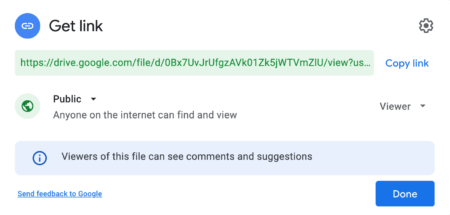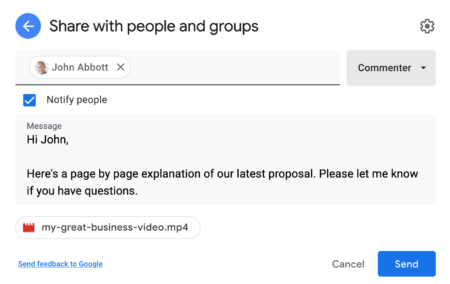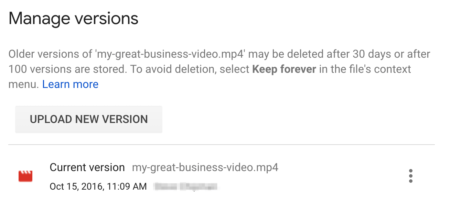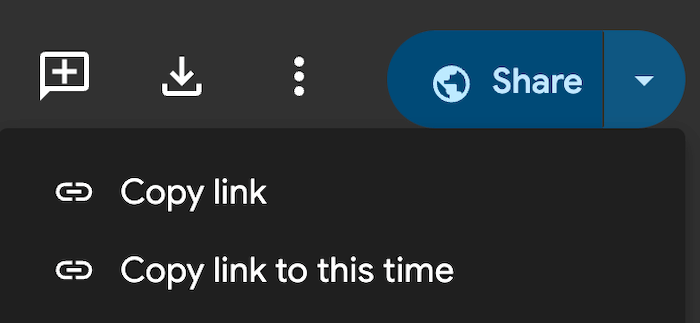If your organization uses Google Workspace, you may have discovered that when you upload a video to Google Drive, it’s not simply a stored file—the video can be played inline.
Moreover, Google Drive uses the YouTube engine to play uploaded videos.
For years, when playing a Google Drive video, the interface appeared like a slimmed-down version of the YouTube player.
However, in October 2024, Google announced a modernization of the Google Drive video player, with improved controls and a less cluttered viewing experience.
Videos can be uploaded to Google Drive by dragging and dropping one or more files at a time into a folder.
As with any Google Drive file, an uploaded video file can be assigned several different sharing options. For example, a video can be shared with just one person. It can be shared with a group of people. Another sharing option is that a video or video folder can be accessed publicly by anyone who has the link:

Note that the ability to share a Google Drive link publicly is enabled or disabled organization-wide by a Google Workspace administrator.
Why Upload Video Files to Google Drive?
There are several business use cases for Google Drive videos.
Allow others to review a video before posting it to YouTube
Since YouTube does not allow for replacing videos, once a video is posted, it can’t be modified. If a video is first uploaded to Google Drive, it can be shared with other users for review. Unfortunately, videos have no “Can Comment” option, but a Doc can be added to the video’s folder for peer comments.
Share a recording of an internal Google Meet
With Google Workspace Business Standard edition and above, Google Meet recordings can be saved directly to Google Drive. This type of video could be shared with all employees—but it would not be shared outside the organization.
Share internal instructional videos
Custom tutorials can be recorded, uploaded, and shared with internal users if a new app is being launched within the organization.
Share videos with prospects or customers
Since any Google Drive user can upload and share a video, a user can record a video or a screencast with content specific to a prospect or customer. The video can then be shared with only that person or group.

Record video in the field and upload it to Google Drive
For realtors, contractors, or anyone else who needs to make video recordings of properties or job sites, the mobile Google Drive app can be used to upload videos to Google Drive from the mobile device’s photo/video library.
Embed Google Drive Videos in slide decks
A Google Drive video can be inserted into a Google Slides presentation.
Tips for Google Drive Videos
1. Google Drive video URLs are long. Before sharing a link in an email, using a URL shortener like bit.ly is best. Plus, you’ll get some high-level activity metrics.
2. Google Drive videos can be embedded in website pages and posts. It’s like embedding an unlisted YouTube video and removing all YouTube branding. A Google Drive video has the exact playback resolution as a YouTube video.
Here’s an example of an embedded Google Drive video. This also happens to be one of our most popular YouTube videos.
Here’s the iframe embed code used to display the above video:
<iframe src="https://drive.google.com/file/d/0Bx7UvJrUfgzAVk01Zk5jWTVmZlU/preview?resourcekey=0-7nlfjW50VpzkLzXdOkhvEw" width="640" height="480" allow="autoplay"></iframe>3. Unlike YouTube, Google Drive videos can be replaced with new versions. This can be done by right-clicking on the video, selecting Manage Versions, and then clicking the Upload new version button.

4. You can upload a caption track to a Google Drive video.
5. If you want to upload many raw footage files to a Google Drive folder, you can do this easily by dragging and dropping a group of video files into a folder.
6. A downside to hosting videos on Google Drive is that you cannot change the still shot or thumbnail that appears.
7. Most versions of Google Workspace have per-user storage limits. For example, the Business Starter edition limits a user to 30 GB (unless additional storage is purchased) of Drive storage. Therefore, users should monitor their available storage—especially since videos tend to have large file sizes.
8. There are no viewer analytics as there are with YouTube and with third-party apps like Wistia and Vidyard.
9. In January 2024, Google added the ability to share a link that takes a user to a specific time in the video.



